|
XWA Montreal: Pre-commercial Broadcasts and Licencing
Part 1, 1920-21
© Arthur E. Zimmerman
D.R.P. "Darby" Coats
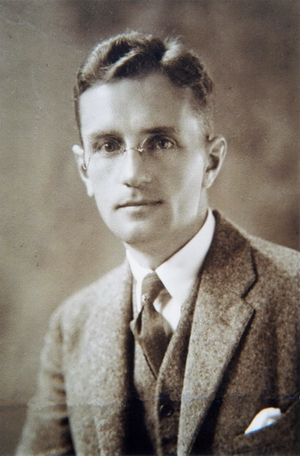
|
|
After a century of speculation about the first experimental broadcast in 1919 by XWA, the Marconi Wireless Telegraph Company of Canada , Ltd., (MWTCC), in Montreal, that mystery is now resolved (1). Despite many published articles about XWA's first "commercial" broadcast on May 20, 1920, very little has been done to clarify details of the actual experimenting with broadcast schedules at the beginning of this "pre-commercial" period, 1920-22. The pioneering engineers tip-toed their way, first exchanging wireless telephone (W/Tp) messages with colleagues and radio amateurs, as the hams did. Clearly, the W/Tp signal was "broad-casted" and no use for private communication, there was no prospect of monetizing it, and the engineers got tired of sending out numbers and the alphabet. When, out of boredom they aired records, the MWTCC brass figured that these W/Tp turns would help sell the hundred crystal receivers built by subsidiary Scientific Experimenter. The engineers felt around for a function for the W/Tp, for material, reached out to the press for news and weather bulletins, relayed remote sporting events and invited locals to perform gratis. One short-lived Toronto station broadcast nothing but stock market reports. Gradually, broadcasting formats developed and the W/Tp found its niche.
Even from the very beginning, the Department of the Naval Services, Radiotelegraph Branch, had mandated that a proces verbal be kept of every time stations transmitted, but those station logs were lost track of fairly quickly, or submitted to the government (2). The main records that we seem to have of this early period in W/Tp broadcasting by the MWTCC survived in the diary and recollections of MWTCC announcer / operator Douglas Richard Proctor "Darby" Coats.
Douglas Richard Proctor "Darby" Coats
So much is known about the early years of radio broadcasting by the MWTCC in Montreal, and particularly of the first year of pre-commercial broadcasting by its station XWA, because of the legacy of "Darby" Coats. Through his many writings and public lectures, it is possible to trace and document what was being aired from day to day as well as to outline his many public demonstrations of the W/Tp in the Montreal area from about 1920. He began publishing MWTCC's radio magazine "Canadian Wireless" in June, 1921, then the series "Adventures in Radio" for CKY Winnipeg's "Manitoba Calling", in 1941, plus a massive 300-page unpublished manuscript for the Canadian Marconi Company called "Canada's Fifty Years of Broadcasting and the Stories Stations Tell: Featuring the Pioneer Station XWA, later given the call letters CFCF, 1919-1969". Coats' post-WW I, diary detailing his work at XWA, survives, plus several boxes of his notes, his photos and other memorabilia.
|
Rescue at Sea by W/Tg
At 5:30 a.m., January 23, 1909, in dense fog off Nantucket, the inbound Florida rammed the outbound, palatial R.M.S. Republic, destroying her engine room. For hours, Republic's Marconi W/Tg operator pounded out CQD, CQD (attention danger) and the ship's position. Several ships arrived, the huge S.S. Baltic took off all 1,200 from both ships and headed to New York. The Florida, bow crushed, limped to Brooklyn docks while the stove-in Republic was towed toward the shoals, but sank off Nantucket. Dozens of such rescues happened over the next years, including Titanic. An international commission mandated that all ships have a 24-hour W/Tg operator.
|
|
|
|
Catching a Murderer by W/Tg
Homeopathic "doctor" Hawley Crippen's philandering wife disappeared and he was seen out with his young secretary, Ethel LeNeve. Suspicious, police searched his London house, finding the wife buried in the basement. By then, Crippen and lover were on the S.S. Montrose, bound for Canada. The captain spotted them, LeNeve disguised as his son, wirelessed the police, who boarded the faster S.S. Laurentic, talking with the Montrose by W/Tg all across the Atlantic. Nearing Quebec City the police, dressed as river pilots, boarded the Montrose and arrested the pair. Crippen was hanged on July 31, 1910, and Miss LeNeve acquitted.
|
|
|
D.R.P. "Darby" or "Drip" Coats was born in Gravesend, Kent, England, on March 23, 1892, built a silicon-crystal wireless receiver in 1910, began working as an articled pupil in the Carnegie Public Library, Gravesend, then studied wireless at the British School of Telegraphy, London. Perhaps he was motivated by the loss of the White Star Liner "R.M.S. Republic" (3) and by the Crippen case.
D.R.P. Coats and W. Whiteside, O.I.C., Marconi station, Tarte Pier, Montreal, 1913. Whiteside was O.I.C. at VCF, Father Point, when the Empress of Ireland sank there
(courtesy Jim Coats)

|
|
In 1911, Coats came to Canada, working for the British Cable Board. He got his Certificate of Proficiency in Radiotelegraphy, 1st class, #16, September 25, 1913 (4), was posted to Marconi station VCC on Quebec Citadel, then VCA at Tarte Pier, Montreal, before going to sea in 1913 as a Marconi Merchant Service wireless operator. He then transferred to the Royal Canadian Navy and was wireless operator on the 765-ton S.S. Morwenna, the first Canadian ship to be torpedoed in WW I, off Cardiff, May 26, 1915 (5). After a posting at VCV, Partridge Island, St. John, by May 1916 he was engaged to lecture at the wireless school of the MWTCC in Montreal (6). At that point, he had already written two articles for their "Shipbuilding and Harbour Construction" magazine and was an operator on the Marconi float in the Victory Loan Campaign (7).
Coats' life-course shifted when Mr. Goldman, former secretary of the MWTCC in Montreal, wired him about a better-paying job at Riordan Pulp and Paper at Temiskaming (8). There he built and installed their first wireless telegraph (W/Tg), receiving nightly news reports from the U.S. Naval Station NAA at Arlington, Virginia. Still a "ham" while with Riordan, Coats was also the temporary secretary of a group organizing a Montreal branch of the Canadian Association of Wireless Amateurs (9). Another shift when Riordan sent him to Montreal and New York to enquire into telephone equipment for communicating between Temiskaming and the engineering office at Mattawa, 27 miles away.
D.R.P. Coats teaching operators at Canada's first wireless school, Shaughnessy Bldg., Montreal, 1917-18 (courtesy Jim Coats)

|
|
In his post-WW I diary, commenced August 18, 1921, Coats recalled that, while visiting Montreal for Riordan, A.H. Morse, the new Managing Director of the MWTCC, offered him an appointment in May 1920 as assistant to the secretary (10), so he returned to the Marconi Company.
Coats was offered an appointment as Publicity Manager in May, 1921, in charge of all of MWTCC's public literature for the press and advertising, plus responsibility for doing public demonstrations of radio in and around Montreal (11). He also became the editor of Marconi's new "Canadian Wireless", Canada's first all-radio magazine, organized radio clubs all over the Dominion and announce-operated weekly radiophone programs over XWA.
Experimental W/Tp Broadcasts on XWA, from 1919
On the morning of March 20, 1919, the day before Arthur S. Runciman made the first experimental radio-telephone broadcast from Marconi's XWA (12), the Executive Committee of the Board of Directors of the MWTCC learned, under "Wireless Telephony", that "Experimental work is being carried out with all dispatch and good results are being obtained with the valves and apparatus available. To facilitate testing, the aerial at the Montreal Station will be erected shortly and as soon as good speech is effected, a demonstration will be given" (13).
After Runciman's first experimental broadcast on March 21, 1919, likely using a Marconi Mark II aircraft transmitter, half a dozen Marconi engineers began playing with the exciting new radiophone technology, operating the makeshift transmitter and manning the microphone in sporadic, unscheduled broadcasts.
Coats named some of the members of this pioneering broadcasting group, including J.V. "Jack" Argyle, J.O.G. Cann, Arthur. H. Morse, A.L.W. McCallum, Arthur Runciman, Jack Ferraris, William Rose, Mr. Humphreys, Reginald Scantlebury, Dick Newman, Max Smyth and Coats himself. He also named George Eaton of Marconi's shore station and of CHCB, both of Toronto, as an early experimental broadcaster (14).
J.V. "Jack" Argyle

|
|
Max Smyth

|
|
C.W. Darling
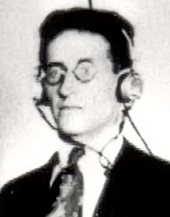
|
|
J.O.G. Cann

|
|
Unsupported reports of early broadcasting exist, such as that the MWTCC was doing "regular broadcasting during the winter of 1919, which practically amounted to a schedule basis" (15). Much later articles said that Walter Darling was the first announcer and Leonard Spencer the first engineer on XWA (16). Walter Darling was certainly there very early on, but Leonard Spencer was an apprentice engineer at the MWTCC from 1919 (at age 18), later claiming to be at the broadcast controls for experimental messages picked up mainly by amateurs. His only datable stories, playing records on a Victrola and broadcasting with Walter Darling from the new studio in the Canada Cement Building, place his activities after December 1920 (17).
Another unsupported story conflated the station airing gramophone records in 1919 along with "gramophone recordings from an old Swedish music box" (18) or else a Swiss music box (19).This nonsense was repeated in articles about the early broadcasts by XWA. In fact, it was a "Nicole Freres" Swiss-made music box with a multi-pinned brass cylinder inside, owned by "Darby" Coats, and first used on air at Christmas,1921.
More officially, Commander C.P. Edwards, once Director of Radio, Department of Marine and Fisheries, said before a parliamentary committee: "Broadcasting in Canada started with some test programs in 1919 carried out by the Canadian Marconi Company of Montreal. Regular organized programs commenced in December,1919 by the same company...." (20).
Actual Documentation of the First Series of Experimental Broadcasts on XWA, 1919
Marconi YC3, 500 watt transmitter/receiver, or FONET (Year-Book of Wireless Telegraphy and Telephony, p. 177, 1920; original FONE pamphlet, L 110/2, Marconi's Wireless Telegraph Co., Ltd.; courtesy Marconi plc, London)

|
|
In September, 1919, the MWTCC was offered two 0.5 KW YC3 multi-purpose W/Tp transmitters, war surplus from the English company in Chelmsford, for $2,000 each plus shipping, insurance and customs (21). The MWTCC bought these large instruments for demonstrations and as a guide to manufacturing such instruments in the Montreal works (22). Soon after, the MWTCC secured letters patent for founding Scientific Experimenter, Ltd., organized to manufacture and sell wireless equipment to amateurs (23).
"By December, 1919, a program of music and speech was transmitted from the Marconi factory with one of those YC3 army transmitters and received by a group of selected citizens in Ottawa. There followed experiments with their two YC3 outfits in and around Montreal "(24).
Marconi Factory, William Steet, Montreal

|
|
D.R.P. Coats returned to the MWTCC only in May, 1920, but left an account of what the initial series of experimental wireless telephone (W/Tp), broadcasts from XWA must have been like in late 1919: "An engineer comes up from the main floor of the factory where he has started a motor-generator which is to supply the current to the wireless telephone. He enters this bare room which is the first Canadian radio studio, throws a switch. The three tubes (on the YC3 transmitter) light up....shining with the brilliance of electric bulbs. There is a pause of a few minutes to allow the tubes to become thoroughly warmed and ready for action. Then the engineer picks up the microphone which looks so much like a common telephone. He holds it close to his lips and speaks thus - 'Hello! Hello! This is wireless telephone station XWA at Montreal. Hello! Hello! How are you getting this? Is it clear? Is the modulation O.K.? XWA at Montreal is changing over', and he would throw over a switch on the front panel of the (YC3) set, turn the tuning condenser dials and stand by listening for the reply from another station operator doing the experiment with him" (25). A little later, the engineers put the little telephone microphone into the narrow end of a straight phonograph horn to amplify the announcer's voice.
First "Commercial" Broadcast and Beyond
Victrola VV IV gramophone, an internal-horn table-top machine with a single-spring motor, a 10-inch turntable and Exhibition sound- box.

|
|
After the founding of Scientific Experimenter in 1919, the MWTCC was trying to sell its receivers to amateurs through XWA's sporadic broadcasts, but the radiophone engineers had grown tired of repeating the alphabet and saying "ninety-nine" or "Hello! Hello test: A ,B ,C, D, 1, 2, 3, 4, 5. How is this coming in? Over" into the little carbon telephone mouthpiece. Coats mused thaf some bored engineer thoughtfully brought in a little record player, and "played and played that same record until the needle had ploughed a furrow....the engineer at the distant receiving point came on and said, 'It's coming in O.K., but PLEASE turn that darned record over!' " (26). In late 1919, that little, borrowed talking machine might well have been the very popular Victrola VV IV, a foot-square, internal-horn model.
Thus, for the May 20, 1920 first "commercial" broadcast, when the station played two 10-inch Victor records on a borrowed machine, it was necessarily on that small machine that played lateral-cut discs. So, for the experimental broadcasts of late 1919, that same little, borrowed talking machine was likely what they were using.
Donald Bankart alleged that, in January,1920, engineer Max Smyth proposed to the general manager that they do regular, scheduled broadcasting. Apparently, that was accepted and Smyth became the radio voice, director and operator of regular Friday radio concerts, with assorted news items (27). No radio logs or other records of any of Smyth's very early broadcasts exist, if there is any truth to that story and, besides, XWA was not yet broadcasting by radiophone on Fridays.
Arthur H. Morse
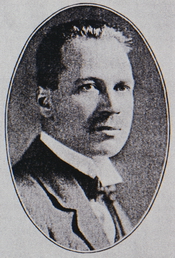
|
|
It is a fact, though, that on Friday, January 23, 1920, from 8:00 to 9:00 p.m., the Scientific Experimenter Department of the MWTCC aired the first of its weekly wireless telegraph (W/Tg) practice bulletins for amateurs on 200 metres and at 10 words per minute (28). Canadian amateurs were "up against it" purchasing wireless equipment from American manufacturers, with a 35 to 50% duty, an additional 10% on the dollar and no rush to fill Canadian orders (29).
On a Tuesday afternoon, in early March, 1920, A.H. Morse gave a talk on wireless telephony to members of the Rotary Club, assembled in the banquet hall of Freeman's Hotel in Montreal and they heard, from the Marconi factory, "a clear, somewhat thin voice" singing "There's a Long, Long Trail a-Winding..." and then a lively waltz played on a gramophone. The ether waves were picked up on a small gridiron-shaped aerial and sent through a reproducing instrument and a Magnavox amplifier (plus a goose-necked loud-talker). The voice from the studio had to have been that of "Gus" Hill, purported to be the very first person to sing over XWA (30). Mr. Morse told reporters about the W/Tp that "Despite the obvious capabilities of the invention, (he) did not think it held commercial possibilities at the present time, unless great developments were made in its practice" (31) and "that there was no present indication of its being developed to supplement the ordinary city telephone" (32).
Sci. Exptr. Marconi Amateur Wireless receiving set for $15, c. December 1919

|
|
Whether the impetus came from the directors or from the engineers themselves, broadcasting of information and music became more regular. "In the spring of 1920 we started broadcasting for promotion purposes, to stimulate the sale of crystal sets" (33).
It is quite likely that "Darby" Coats, J.V. "Jack" Argyle and others more or less took turns after May 20, 1920, as engineer / announcer, still in irregular, sporadic, not pre-announced broadcasts of news, weather reports and recorded music. No station logs of these broadcasts exist.
Coats' Lectures
"Darby" Coats' other duties included setting up and doing wireless demonstrations and lectures for various groups, noting many of these in his diary. A. J. "Lorie" Lorimer recalled in 1940 a "very wonderful" public demonstration of W/Tp that they had done at the Mechanics Institute. The equipment that they erected on the platform consisted of a 14-inch loop antenna and a 1,200 metre receiver with a Marconi 7- or 11-valve amplifier (V24 and Q valves), the output fed into a Magnavox power amplifier and loudspeaker (34). The complete "recipe" for a receiver, mounted in a triple-decked cabinet on rubber-tired wheels, was: a loop antenna, two 6-volt storage batteries; three 22 and a half-volt "B" batteries; one type 55 A amplifier with six V24 tubes and a Q detector tube; a tuning unit in a mahogany and hard rubber box and a "Brown" or "Magnavox" loud speaker looking like an ear-trumpet (35).
Switch from a Flat-disc Talking Machine to an Edison Diamond Disc Machine in 1920
Why did the Marconi engineers at XWA decide to abandon the small gramophone with lateral-cut disc technology after May, 1920, in favour of Edison vertical-cut technology? This is purely speculative, based on just a couple of
knowable points.
Edison Diamond Disc machine, C-19 Chippendale model, full cabinet upright with double-spring motor, available from c. December, 1919

|
|
As stated above, in the first "commercial" broadcast, May 20, 1920, XWA played two record sides, one of John McCormack singing Gitz Rice's "Dear Old Pal of Mine" on 10-inch Victor Red Seal 64785, and another disc of a dance band. Although no other evidence exists, it is quite possible that the two 10-inch discs were played on a small Victor machine, perhaps the popular little VV IV table-top with a 10-inch turntable and internal horn. This Victrola IV has a single-spring motor which could play a 10-inch 78 RPM side completely through if it were fully wound and in good condition. Because of the weak spring, a less than full winding might result in the machine slowing down before the end of the side. Furthermore, the process of getting a record on the air was tricky. The announcer / operator would have had to change discs on the turntable, fully re-wind the machine and replace the steel stylus before back-announcing the previous record and introducing the next, then release the brake, drop the tone-arm onto the disc and swing the hanging horn-microphone to the open mouth of the talking machine. Going through that process would have meant a lot of dead air between records.
For whatever practical or technical reasons, for the broadcast series that followed after May,1920, the engineers decided to upgrade their record player. "In the interests of economy, they refrained from buying a phonograph". Instead, they asked Layton Brothers' Music Store on St. Catherine West to lend them an Edison Diamond-Disc machine, a high-end Chippendale model, and some discs, plus a Layton player piano and some rolls, "in return for suitable acknowledgments on the air....I suppose the first sponsored programs" (36).
Coats left an account of these 1920s activities with the new Edison machine too: "The radio works is a square two-storey building.....Upstairs to the top floor we go. Here are lines of lathes, drills, coil-winding machines and all the gadgets of a radio factory of the period. Girls at benches are shaping and taping sections for armature windings. The pervading smell is heated rubber and shellac. At the rear of the building is the test room, where engineers wearing headphones move about or peer at meters and say 'Ah' as they turn knobs and alter adjustments....We stroll along a lane of lathes toward the front of the building. Here are draftsmen busy....Adjoining the offices is a small room in which stands a teak box shaped like an upright piano - obviously a brother of those (YC3 Fonets) like we saw in Chelmsford. Our gaze wanders round the room and takes in a phonograph, one of the old Edison Diamond-Disc machines. The floor is bare and quivers with the vibration of machinery. The sides of the room are painted white and the rough ceiling beams are white-washed. From one of them hangs a length of string, to the lower end of which is attached a piece of wire bent into the form of a hook. From the top of the teak box-piano contraption, a heavy wire goes to an insulator, connecting we suppose with an aerial on the roof.
Young Willie Eckstein at the piano (Mail & Empire, Toronto, September 5, 1903, p. 10)
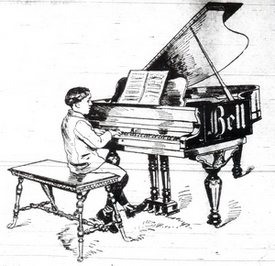
|
|
"The front of the (YC3) box opens down to make a table for writing paper, disclosing three vacuum tubes looking like so many giant glass bubbles, some five or six inches in diameter. In cupboards under the table are a transformer and other vital parts, connected directly or indirectly by concealed wiring with the vacuum tubes, the telegraph keys and an intricate assembly of condensers, chokes, inductances, meters, hard-rubber knobs....At the right of the box, above the desk or table, is a radio receiving set panel, along the face of which are arranged seven small glass tubes standing upright in a row.....A pair of headphones is provided for the operator of the radio set and ....lying on the table something resembling a telephone transmitter.....the microphone." He then outlines the procedure, described above, for starting the motor generator and the throwing of a switch on the YC3, so that the giant tubes light up (37).
The engineer / announcer's job was now to crank up the new Edison machine, change discs on the turntable, make an announcement into the (telephone-type mouthpiece lying on the desk, or into the amplifying upgrade) phonograph horn hanging from the hook on the ceiling-string, swing that horn into the open mouth of the record player, release the turntable brake to set the disc in motion and raise the lever to drop the Disc Reproducer with stylus into the lead groove.
Gus Hill
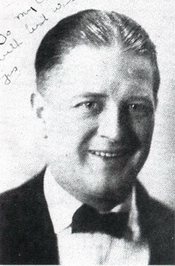
|
|
In Coats' own words, "...When we had said our little piece, holding the microphone in our left hand as we cranked the phonograph with our right, we (switched records on the turntable), placed the (Disc Reproducer with) needle in position (over) the record, (released the turntable brake, raised the lever to lower the Disc Reproducer apparatus), turned the microphone horn upside down, hung it on the hook at the end of the string within a foot of the (reproducer's) horn - and gave the audience a treat.....Song publishers generously sent their 'pluggers' to sing at our microphone, so that their products might be popularized....In the early days there were artists who might without difficulty have been persuaded to pay us for the privilege of broadcasting. Many...who gladly performed gratis......The first live talent I remember putting on the air....was one 'Gus' Hill, a singer of popular ballads (and Berliner recording artist) (38), who brought with him the nimble pianist who played for silent pictures in the Strand Theatre on St. Catherine West, Willie Eckstein (39). I can see 'Gus' yet, pouring out his heart into the (large end of) the tin-horned microphone which dangled on a string, the transmitter tubes protesting in spasms of blue brilliance.... whenever he took a high note. I can see Willie, bending over the keys of the light-oak piano while the music rippled from his fingers. There was no monitoring operator. I just kept an eye on the meters of the transmitter to see that we were still on the air, and that was that" (40).
The YC3's tubes went crazy whenever "Gus" hit a high note because the microphone embeded inside the horn was essentially a telephone mouthpiece, designed for speech and not for music.
Switching to an Edison machine, with a much stronger, double-spring motor, would have meant fewer winds between sides and its Disc Reproducer tone-arm has a permanent, built-in diamond stylus, so no need to replace a worn stylus after each side. The problem with Edison was that their record catalogue, all of vertical-cut discs, was much more limited than the Victor, comprising lots of sentimental old songs, hymns, marches, racist ditties, grand opera and rural humour. The Victor and Columbia catalogues contained much currently popular music and even some fashionable syncopated "jass". So, the earlier switching to Edison had been a trade-off in listener appeal and taste.
Documentation of the broadcasts over XWA following the first "commercial" broadcast of May 20, 1920, again come from the diary and writings of "Darby" Coats. Undocumented, sporadic broadcasts were made over XWA for the rest of 1920, perhaps becoming regular later, after the gift of a Victrola and discs by Berliner and Victor in November, 1920, but no documentation of those early broadcasts survives until the early spring of 1921. They held onto the Layton Brothers' Edison Diamond Disc machine through 1921, because in the Christmas Eve broadcast that December, Coats mentioned Santa Claus having one there for a "grown-up" (41).
Mr. Price-Green with the Marconi V55A receiver, box of 7 Fleming valves and Magnavox loud-talker on his lawn in Mimico
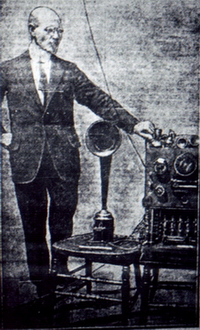
|
|
Radiophone Demonstration at the C.N.E., August 1920
"Darby" Coats was busy. To Toronto that month, where he and a Marconi team first set up 3 temporary W/Tg sets operating at 200 metres, to monitor and time speedboat races in the harbour (42). Then the MWTCC applied to exhibit W/Tg and W/Tp at the Canadian National Exhibition (43). In their Merchant Marine wireless operators' uniforms, they moved and set up Toronto's YC3 radio-telephone-telegraph transmitter/receiver from the King Street station into a booth in the Railway Building and a 1.7 kW ship's rotary spark-gap set in a neighboring booth. With permission of the Dept. of Marine & Fisheries, they did W/Tg demonstrations across the C.N.E. grounds and sent W/Tp "concerts" at 1600 metres from a New Edison Diamond Disc machine over to the Horticultural Building. There, receiving equipment was installed in the Edison booth, about 100 yards away, and operated by Fred Barrow (44), but the noise and line-ups bothered the horticulturists, requiring reducing listening hours and using of individual head-sets (45).
They had a request from Mr. Price-Green, C.N.E. Commissioner of Industries, to receive a broadcasts on his lawn in Mimico, three miles away. The press was invited. Fred Barrow set up the Marconi V55A receiver with 6 Fleming valves and a Magnavox loud-talker, and strung a 40-foot aerial from a bedroom window to a 30-foot oak tree (46). They heard Edison record "Into My Daddy's Arms", something from "Cavalleria", but at 11:55 the local W/Tg weather station at 600 metres drowned out the music (47). Photos exist of the New Edison booth and of the equipment in Mr. Price-Green's garden (48).
From Edison Diamond Discs Back to Victor Discs on a Victrola
Victrola 80
These machines were introduced to the public in the spring of 1921, but it's likely that Montreal Victor already had them in stock by late November, 1920.

|
|
The situation changed at XWA as of November 30, 1920, when the Berliner Gram-O-Phone Company, Ltd., of Montreal, announced that, "By agreement with the MWTCC, a 'His Master's Voice' Victrola Concerts, featuring the latest and most popular selections will be given to-night and on every Tuesday night from 8 to 9 p.m. for the benefit of Wireless Students.....There are many radio receiving stations in and around Montreal that can receive wireless telephone communications. Look for one in your neigbourhood. Find out who your friends are that may have one.....Stations within a radius of two hundred miles of Montreal should be able to enjoy these Wireless Telephone concerts, as every record will be heard as clearly and distinctly as though it was playing on your own Victrola, in your own home....Operators tune to 1,200 metres" (49). An almost identical notice appeared later about the Toronto MWTCC station, for concerts every Tuesday, 8 to 9 p.m. at 1,200 metres (50). "For the initial wireless 'concert', Herbert Berliner invited the several members of the Berliner Company to his home to hear the musical show....HMV records, featuring Kreisler, Lauder, Billy Murray, Lewis James and the orchestras of Coleman, Raderman and Henri were played..... heard.....by at least 150 persons or groups as far distant as Ottawa and Father Point, Quebec" (51).
"Darby" Coats, as engineer and announcer in late 1920, had to go back to the Victor lateral-cut technology, crank up the new floor-model Victrola (possibly the soon-to-be-released Victrola 80 or 90, with 12-inch turntable, double-spring motor, improved nickel-plated Victrola No. 2 soundbox and semi-automatic brake; but no confirming photos exist), replace the disc on the turntable, replace the worn stylus in the Victrola soundbox, read the news, weather report, announce the next record information into the hanging phonograph horn, swing the pickup horn into the mouth of the Victrola, release the turntable brake and drop the stylus into the lead groove. The whole process had to be repeated for each record.
Broadcasts from Spring of 1921
The earliest documentation of regular "radiophone concert" programming is in the premier issue of "Canadian Wireless", compiled in May, 1921 (52). But these "radiophone concerts" were in progress earlier, with mentions found for April 12 (53) and a concert for the blind on April 19 (54). Fred Barrow recalled that the first XWA regular Tuesday program of music, arranged in co-operation with the Berliner Gram-O-Phone Company, was that one on April 12, 1921 (55), during Coats' lecture to the Electrical Co-operative Club at Freeman's Hotel.
Advertisement for concert of "His Master's Voice" records by W/Tp from Montreal Marconi at 1,200 metres (MDS, November 30, 1920, p. 2, Mtl Gaz, Nov. 30, 1920, p. 4)
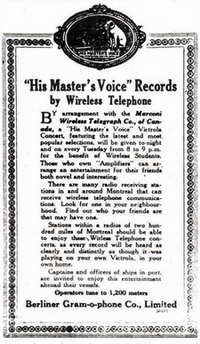
|
|
Coats began his post-WW I diary on August 18, 1921, and his first notation of his broadcasting in that diary was on Tuesday, August 23, 1921, when he wrote about running the W/Tp concert for Scientific Experimenter from 7:45 to 9:35 p.m. that evening.
"Darby" Coats later wrote that "the weekly wireless telephone concerts radiated from the Toronto office are meeting with ever increasing popularity among the amateurs.....at that time I was broadcasting similar weekly programs from the Company's factory in Montreal" (56).
J.V. "Jack" Argyle took over the W/Tp duties from August 24, 1921, while Coats took a needed vacation, and Coats did the program on most Tuesday evenings until the schedule changed after Christmas, 1921. Coats hosted on Thursday, March 2, 1922, when "The Society Trio" played for listeners. A pianist came in for his last broadcast, Monday, March 6, but played only one piece. Another operator was at the microphone when Coats lectured to the High School Scientific Society on Saturday, March 18, relaying the XWA concert of records (57). In those pre-commercial days, when no radio logs seem to have survived and no real program format established, programs of mostly gramophone records, invited "live" musicians and weather reports, were improvised. At some point, Coats mentioned hanging the microphone out of the unscreened window to pick up street noises plus a squadron of flies, or having a crowd applaud or jeer from the street at his choice of music. The national anthem drew booing, cat-calls and rock-throwing at his open window (58). On Tuesday, September 20, 1921, Coats had his future brother-in-law Fred Cooper in to play the borrowed Layton Brothers piano in the little studio.
At that time, the weekly broadcasts from Marconi's CBCB, Toronto, were announce/operated by veteran W/Tg operator George Eaton.
The First Santa Claus Broadcast on XWA, Montreal
"Darby" Coats told stories of two Santa Claus broadcasts that he did from XWA, Montreal, first in 1920 and again in 1921.
"At the request of Mr. A.H. Morse, managing director, I played Santa Claus on the air for the specific purpose of speaking to the Morses' little girl, on Christmas eve, 1920" (59).
Years later, he wrote of that first program ".....As we had arranged a program of recorded music appropriate for the season, it occurred to us as an almost last-minute idea that we might introduce Santa.....The notice was short and there were no sleigh bells, but Santa arrived at the William Street studio with his familiar 'Ho! Ho! Ho!', introduced his reindeer, spoke of dolls and toys for good girls and boys, and dashed off into the night. The known audience on that occasion numbered a few dozen only, as the event occurred to us too late for advertising in the press" (60). That year, Christmas Eve was on a Friday.
The Second Santa Claus Broadcast on XWA, 1921
The next year, an advertisement by Layton Brothers appeared in the Montreal newspapers announcing a second Santa Claus wireless telephone program from XWA at 1200 metres, from 7:30 until 8:30 p.m. on Christmas Eve (61).
|
|
Layton Brothers advertisement for Santa‘s 1921 Marconi Wireless broadcast, showing the Layton player piano and the new Edison machine playing
into the YC3 horn at the Marconi station
(MDS, December 23, 1921, p. 18)
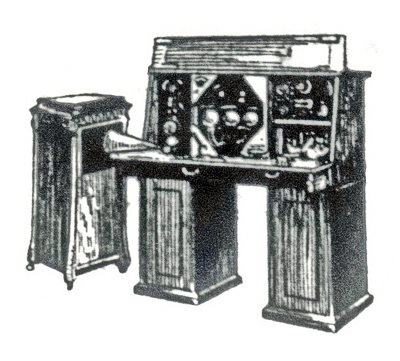
|
|
In his diary, Coats wrote on December 24, 1921, that he "went back to town with (girlfriend) Amy in the evening. Bought a set of sleigh bells & went down to the factory and ran 'Santa Claus' concert on wireless phone".
Santa Claus W/Tp broadcast advertisement (MDS, December 20, 1921, p. 3;. December 22, 1921, p. 16)
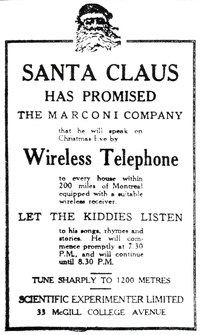
|
|
"The feature was somewhat elaborated on Christmas Eve, 1921.....On the dot of seven-thirty, the performance began. Perhaps a hundred or more pairs of eyes opened wide with childish wonder as a corresponding number of little ears listened in to the jingle of sleigh bells and heard Santa Claus talking on the wireless telephone.....Santa's voice came through with many 'Ho! Ho! Hos!'. The sleigh bells jingled louder and louder until the kindly old gentleman pulled up his reindeer with a 'WHOA!' and set the ether trembling with a 'Merry Christmas to you all, my dears!'
"Darby" Coats' music box by "Nicole Freres", c. 1860, inherited from his grandfather (photo courtesy Jim Coats, c. October, 2000).
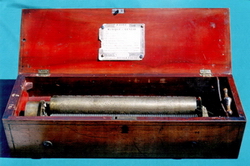
|
|
"Santa played on his musical box, a tin trumpet and a harmonica. He even had an Edison Diamond Disc phonograph, for a 'grown-up' no doubt, and played some pieces on that. Punctually at half-past eight he jumped intp his sleigh, shouted to his reindeer and with a jolly rolling 'Merry Christmas!' becoming fainter as he went on his journey among the chimneys. ..and... .faded into the night (62).
"A little later the same evening, Santa visited the Marconi station in Toronto, where manager George F. Eaton officiated in welcoming him and cheering him on his way " (63). In 2001, Bill Tarling of CAPS remembered hearing Santa on the radio when he was six years old, possibly over CHCB, Toronto (64). Christmas eve was on a Saturday in 1921.
"Darby" Coats' musical box with multi-pinned brass cylinder, No. 34605 made by Nicole Freres circa 1860, inherited from his grandfather, "introduced Santa Claus many times since then.... It plays eight tunes, mostly from Verdi's operas", all "modern" music of the mid-1850s (65).
© Arthur E. Zimmerman
Radio Broadcast by Dame Nellie Melba, "Live" on XWA, Montreal in 1921
The young Nellie Melba as Rosina in Rossini's "Barber of Seville" (undated)

|
|
In the 19th century, fine coloratura and lyric sopranos were treated like royalty and some divas, such as Nellie Melba, comported themselves like queens.
By 1901, quite a few major operatic artists had recorded for Bettini, Pathé and Russian Red Label, all of which had limited circulation. They were reluctant, however, to commit to recording for G&T. The dam broke after Fred Gaisberg gambled on recording the young Caruso in 1902. The sales were so huge that the biggest stars deigned to have their voices preserved on spiral discs: Francesco Tamagno in 1903 and Victor Maurel and Nellie Melba in 1904.
Melba was always interested in new technologies, but she did not like the sound of her voice on her first records, which were not able to reproduce her pure tones. As the technology improved, she became delighted with her discs. Over the years, she recorded some 181 sides for the Gramophone Company and Victor. She wrote that recording for the gramophone was one of the most nerve-wracking ordeals in her life. In a little room, she had to sing into a hole in the wall, with her flute accompanist tight beside her. She had to lean back when taking a high note and, at the end of a side, had to be very quiet until the all-clear signal. Once, after recording a beautiful side, she stumbled backward, fell over a chair and said, "Damn!", which the recording apparatus picked up clearly. (See Nellie Melba Museum)
Not only did Melba willingly venture into acoustic recording on disc, but she was likely the first big opera star to dare to allow her voice to be heard in a pre-advertised broadcast, sent out instantaneously by the new-fangled radio, then termed the wireless telephone (W/Tp). In fact she broadcast "live" twice over W/Tp: first from Marconi's home station near London and one year later from the fledgling Canadian Marconi station in Montreal. Details of the Chelmsford broadcast are known but here, for the very first time, APN readers will learn of the Canadian story.
Dame Nellie Melba, broadcasting from the Marconi radio station MZX at Chelmsford, England, June 15, 1920, "the world's first advertised radio broadcast"
(photo courtesy Marconi plc, England; Letter from W.T. Ditcham, July 1918, courtesy Marconi Museum)

|
|
Dame Nellie Melba "live" on Radio
On June 15, 1920, by arrangement with The Daily Mail, the great Australian prima donna and recording star Dame Nellie Melba (Mrs. Helen Porter Mitchell; 1861-1931) sang from the little studio in the Marconi Wireless Telegraph works in Chelmsford, Essex, and that W/Tp broadcast was heard over the British Isles and a large part of Europe, including Berlin, the Hague, Christiania and Warsaw.
The broadcast was supervised by W/Tp pioneer Capt. Round, with W.T. Ditcham out at the transmitter. Melba had to sing an extra yard back from the microphone, installed inside a cigar-wood box, and not close as shown in the photograph.
Before the broadcast, Dame Nellie was shown the station's two 450-foot radio masts and was told that her voice would be heard from the tops of those towers. She retorted, "Young man, if you think I'm going to climb up there, you are very much mistaken".
Melba was not required to climb those towers. On her broadcast, she started with a long trill - too loud so was pulled back by a yard - then sang "Home Sweet Home", Bembini's "Nymphes et Sylvains", "Addio" and another aria from Puccini's "La Boheme" and "God Save the King" in both French and English. In Paris, a phonograph record of the singing was cut, and Melba said, "I greatly enjoyed this most wonderful experience of my life" (66).
After Melba's broadcast, there quickly followed W/Tp concerts from Chelmsford by Danish tenor Lauritz Melchior, and the great English contralto Dame Clara Butt, who may not have needed wireless for her powerful voice to reach Europe. Sir Thomas Beecham said of her that, on a clear day, from Dover her voice could be heard all of the way across the English Channel in Calais, France.
In July, 1920, Danish heldentenor Lauritz Melchior (1890-1973), and later Dame Clara Butt (1872-1936), sang into the same Marconi W/Tp cigar-box horn at Chelmsford, England. At far left is W/Tp pioneer W.T. Ditcham, "whose voice was first to span the Atlantic from east to west".
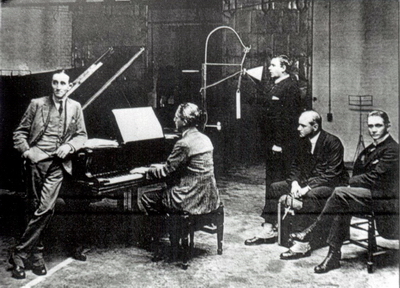
|
|
Dame Clara Butt, English contralto, recitalist and concert singer, had a powerful voice and stood an Amazonian 6-feet 2 inches tall.
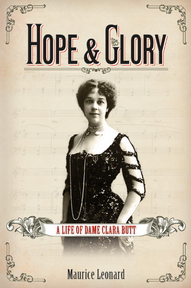
|
|
Melba's Silent Visit to Canada
Melba had had a gruelling schedule in those years, returning from concerts in America on March 24, 1919, received by royalty (67), starred in the first post-war Covent Garden season (68) and then again to America and back (69). She did the W/Tp concert at Chelmsford in June (70), contracted throat trouble in Italy, was ill with the grippe (71), but she sang in Monte Carlo (72) and Brussels (73), then to the south of France for her health (74). Melba gave her au revoir concert at the Royal Albert Hall, London (75), and left for Australia via Canada in June, 1921 (76). She was very tired and was going home to Australia for a vacation, to see her aged father and have a real rest. Therefore, she announced that this would be a silent visit to Canada.
Her ship, the White Star liner "Megantic", ran into fog and ice off Newfoundland and then responded to an S.O.S. from the American steamer "Charlot", which had struck an iceberg. Therefore, Melba arrived in Quebec City a day later than scheduled, on Monday, June 13 (77) and, though she had announced that she would be staying with friends (78), was booked at the Ritz-Carlton Hotel in Montreal.
Melba was feeling fine after the voyage and declared, "Indeed, I have never felt better since my long illness, and I am now ready to start singing again....I shall be in Montreal only two days and leave on Wednesday by the Trans-Canada Limited for Vancouver, from where I shall sail on the 'Niagara' for Sydney" (79). The plan was to spend the summer with her family in Melbourne and return to London in March (80).
That first afternoon in Montreal, she attended the races at Blue Bonnets. Before that a luncheon for 120 of Montreal's highest society in honour of the retiring Governor-General and the Duchess of Devonshire, given by Mr. J.K.L. Ross, President of the Jockey Club (81). Also present were Sir Mortimer Davis, President of Imperial Tobacco of Canada and of other big corporations, Miss Louisa Molson, Brig.-Gen. Meighan, Hon. L.A. Taschereau and Mrs. R.A.E. Greenshields, surely a relative of prominent lawyers Mr. James N. Greenshields, former Director and President of the Marconi Wireless Telegraph Company of Canada (MWTCC), and Charles G. Greenshields of the Board of Directors of the MWTCC (82). The luncheon menu featured "Strawberry Melba" in honour of the great diva.
At the races, Mme. Melba spent a short time conversing with the Governor-General and the Duchess in the vice-regal box (83). Melba wore a black and white cloth costume, a black cape and a large, black mohair Gainsborough hat trimmed with black feathers (84), while proper attire for gentlemen included a silk hat, Ascot tie, chamois gloves, morning coat, double-breasted waistcoat and white spats (85).
Melba's activities in Montreal on the 13th are well documented - on her first evening, Melba was guest of honour at a dinner given by Sir Mortimer Davis, who would soon have a private office in the new Canada Cement Building where the Marconi radio station would be re-located (83). But the 14th, the day before she left and then the day she took the late afternoon train for Vancouver, are a blank. She had contacts with Sir Mortimer Davis, Mrs. Greenshields and likely others who had business connections with the MWTCC, so it's possible that she was invited to the Marconi factory on William Street and was persuaded to sing a couple of songs into radio station XWA's phonograph horn, all a capella, since there was no piano there. After all, she had confided to the press that she was feeling better after her ocean trip and was ready to start singing again (79).
None of the National Library of Australia (86), the State Library of New South Wales (87), the Lilydale & District Historical Society (88), the Melba Memorial Conservatorium of Music in Victoria nor Nellie Melba's granddaughter, Pamela, Lady Vestey (89), knew any details about Melba's silent visit to Montreal and whether it was actually silent. Everybody in the XWA crew respected Melba's vow of making a silent tour, until D.R.P. "Darby" Coats recollected the event some forty years later, but cited an impossibly early date in 1920. No other record of that broadcast has been found. If station broadcast logs were ever made in those days, they are long lost and no amateur listening logs seem to have surfaced either. "Darby" Coats has proven, however, to be a most reliable witness and recorder of events at XWA, all of his other recollections checking out absolutely correctly.
(See XWA Montreal: Pre-commercial Broadcasts and Licencing Part 1, 1920-21 by Arthur E. Zimmerman, APN, summer 2021). Therefore, there should be no doubting of the veracity of his story.
Coats' Recollection of the Melba Broadcast over XWA
"Darby" Coats recalled: "One of the world's best-known operatic sopranos was not too proud to sing into the crude combination of phonograph horn and carbon 'mike'. She was Dame Nellie Melba who, during a visit to Montreal, went to the improvised 'studio' and sang several numbers. Few people were equipped with radio receiving sets in their homes at that time (May 1920), but Dame Melba is said to have greatly enjoyed the unusual experience, as did those who were listening" (90). Actually, Melba's brief visit to Montreal was in mid-June, 1921, a year after XWA's first "real" broadcast (91), so "Darby" Coats was off by a year. He could not have been mistaking another Australian soprano, Frances Alda, who concertized at the Francais Theatre, Montreal on May 26, 1919 (92), too early for any XWA in-studio wireless telephone concert.
The clincher to the Montreal broadcast story is Coats' note in his testimony that, true to her indomitable character, "Dame Melba is said to have greatly enjoyed the unusual experience".
Continuing her Voyage to Vancouver and Home
Mme. Melba arrived in Vancouver some days before schedule, where she was met by her grand-daughter (later Pamela, Lady Vestey). She registered at the Hotel Vancouver, was still not in the best of health and re-stated that this was to be a silent visit (93). She attended and personally opened the garden fête of Mrs. Gardner Johnson, under the auspices of the Coronation Chapter, I.O.D.E., and auctioned her autographed photos in aid of the chapter's funds (94). She lamented that Vancouver did not have a concert hall (95), was patroness of the local production of Massenet's "Manon" (an Army and Navy Production, for soprano and tenor only, with piano), held in the open air in the Tea Garden, Stanley Park on July 8 (95). On account of illness, she was unable to attend the Kiwanis Club's "Rose Ball", where she was to raffle off three boxes to "Manon" (96).
Melba's first concert after returning home was at Sydney Town Hall on August 8, with orchestra under Henri Verbrugghen, Una Bourne at the piano (97). Her home-coming concert was at the Town Hall in Melbourne on August 31. She stayed in Australia longer than planned. Her farewell concert was in Melbourne, September 4, and then she left for Bombay (98), later leaving Simla for England (99) and returned to London at the end of October, 1921 (100).
Nellie Melba's Farewell Concert, Covent Garden
The "Melba Farewell" to her career was an exhausting gala of opera scenes at Covent Garden, London, on June 8, 1926. The Gramophone Company's lathes captured two excerpts from the beginning of Act 4 of Verdi's "Otello", chunks of Acts 3 and 4 of Puccini's "La Boheme", and Melba's farewell speech, all recorded "blind" by land-line at Gloucester House. Of the eleven 78 RPM sides taken, only four were issued at the time, including the farewell speech (101).
Advert for the Dempsey-Carpentier fight, (Montreal Daily Star, June 30, 1921, p. 17)

|
|
Other XWA Outreaches in 1921
Dempsey-Carpentier "Battle of the Century", July 2, 1921
XWA broadcast the results of the Dempsey-Carpentier fight from Tex Rickard's purpose-built arena in Jersey City. Reports were sent all over the continent by ticker-tape or wire from ringside that afternoon. Montreal got the reports by arrangement with The Montreal Standard, as part of the first mass broad-cast in history. Once at the newspaper office by W/Tg or land-line wire, the reports were then conveyed, likely by telephone, to the Marconi plant. With interludes of recorded music, end-of-round results were broadcast by W/Tp and W/Tg, including Carpentier being counted out in the fourth round (102). Some heard the broadcast at a football game at Greenfield Park, others on a motor boat on the St. Lawrence (103).
At its head office, The Star did the usual, posting bulletins and announcing results by megaphone (104).
Photo of the wire-rigged Montreal Standard motor launch with Marconi W/Tp for the International Yacht Races on Lake St. Louis (MDS, July 27, 1921, p. 18)

|
|
Marconi Radiophone at the Yacht Races, July 23, 1921
During the Seawahna Cup Yacht Races on Lake St. Louis, it had been difficult to report the positions and times of the boats. The signals and signal-guns gave poor results so, for this Royal St. Lawrence Challenge Cup Race, The Montreal Standard arranged with the MWTCC to report from the middle of Lake St. Louis by W/Tp. A small motor launch was rigged with 15-foot masts, fore and aft, with 3-strands of 20-foot copper wire between. A small, 30 watt Marconi YA transmitter in the bottom of the boat, plus batteries and a hand-cranked D.C. generator for plate voltage, sent W/Tp at 400 metres to a receiver atop the lighthouse at Nun's Point, on the grounds of the Point Claire Convent. From there, the results were sent by wire to The Montreal Standard offices, where they were written up for type-setting (105). The Star later claimed that the W/Tp reporting was their project (106). Perhaps the rival newspapers co-operated.
Photo of the exhibit of household electrical equipment, by Montreal Light, Heat and Power, Sept.- Oct. 1921. Marconi signs are evident here. (Mtl. Std., October 1, 1921, p. 2)
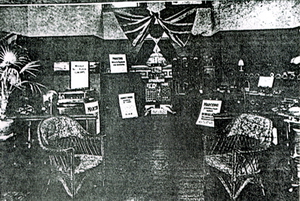
|
|
Radiophone at the Heat, Light and Power Exhibition, Montreal, Sept. 15, 1921, with YC3
Montreal Light, Heat and Power staged an exhibition of "household science" at the Consolidated Uptown Power Building at St. Catherine and Mountain Streets, from September 15. Among the many exhibits there, designed to promote the use of electricity in the home, were washing- and wringing-machines, stoves, vacuum cleaners, fans, irons and hair-curlers, plus W/Tp and X-ray machines. Music was brought in from the Marconi office with one of their YC3 Fonet transmitter/receivers (107).
Announcement of MDS's arrangements to broadcast election results by Marconi wireless (MDS, Dec. 5. 1921, p. 1)

|
|
Dominion Election Returns, December 6, 1921
The MWTCC made "very complete arrangements" with The Montreal Daily Star "for collecting, tabulating and bulletining the election returns". The returns were received at The Star over Canada Press wire and from correspondents all over Canada, compiled at The Star's office on St. James Street, then relayed to several news outlets and transmitted by radiophone from William Street (108). Incidentally, Mackenzie King's Liberals were returned to power, defeating Arthur Meighen and the Conservatives.
Royal Astronomical Society and McGill and Verdun Radio Associations
On November 29, 1921, Mgr. C.P. Choquette was to lecture to the Royal Astronomical Society, with fellow R.A.S member Coats later to demonstrate reception of W/Tp from William Street. The meeting was abruptly called off, but they decided to carry on with something, so "Darby" Coats made an impromptu "stump" speech and did the W/Tp demonstration (109). The meeting was re-scheduled to December 15 (110).
Always busy, with very many other duties, Coats lectured and demonstrated W/Tp to the McGill Radio Association on December 13, 1921 (111), to the Verdun Radio Association on March 13,1922 (112), and to the Electrical Luncheon at Freeman's Hotel in April (113).
In late 1921, the MWTCC in both Montreal and Toronto, were still broadcasting news, market reports and musical entertainments every Tuesday from 8:00 to 9:30 p.m at 1200 metres and 0.5 kW (114).
Toronto Serenaders, c. 1921-22, in the Toronto Marconi station, CHCB, Victoria Block, 93 King E. Left to right, Will G. Cottenden (drums), George H. Smith (piano), James R. Fraser (saxophone), R.N. Cornfield (violin) and operator George Eaton with the Marconi YC3 transmitter (PAC PA 003114; "First Wireless Concert"., Main & Empire, March 23, 1921, p. 4)
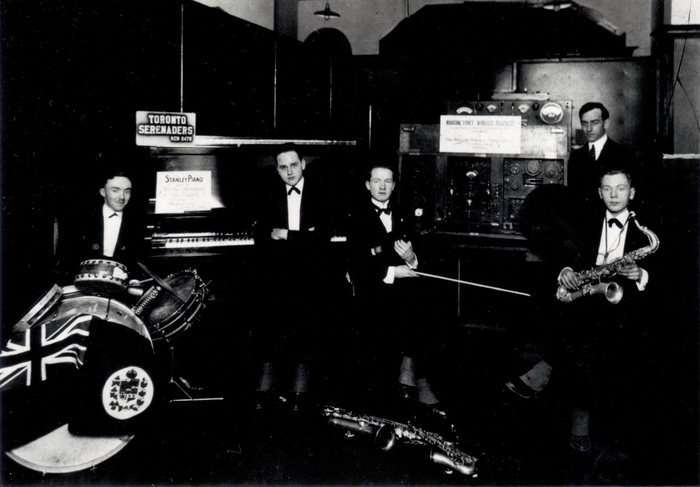
|
|
Changes in Licencing and Hours
Some time in late 1921, the Department of the Naval Services did away with all of the wartime and post-war X-calls for amateur experimental wireless stations. The MWTCC's XWA call was changed to a 9-call, specifically 9AM, the license for a Canada-wide, amateur experimental station. The authorities were still classifying all wireless operators as amateurs, even though some like the MWTCC station were supplying occasional programming of wide public interest (115). As station 9AM, they were still broadcasting at 1,200 metres every Tuesday at 8 p.m. and soon at 1.5 kW (115).
On January 6, 1922, the MWTCC' station manager Andrew L.W. MacCallum requested authority to extend their programming hours to every evening of the week, except Sunday, between the hours of 8:00 and 10:00 p.m. Such permission had already been granted to CHCB, the MWTCC station in Toronto (116). Permission was granted on January 9, 1922 (117).
A note appeared, reporting that the Marconi Phone Concerts at Montreal would be radiated at 8 p.m. on Monday and Thursday evenings at 1,200 metres, commencing Monday, January 23. The Tuesday evening concert would be discontinued (118) They now had a new YC3 transmitter, at 1.5 kW (119).
March 23 - Application for "Public Commercial"
The Department of the Naval Services announced that, with the expiration of the current licenses on March 31, 1922, in accordance with the new International Radio Convention, it was preparing a new form of "Public Commercial License" for re-classifying experimental stations authorized to perform broadcasting services.
Under the new international convention, all Canadian public commercial stations were given C-calls, while stations in the eastern U.S.A. got K-calls and in the western states got W-calls.
The department confirmed that the Montreal Marconi station was allotted call CFCF at 440 metres. Accordingly, Deputy Minister Desbarats informed the MWTCC on March 14 that licenses #148 and 149, issued to Scientific Experimenter, would no longer be "Experimental" but, as of April 1 would be re-classified as "Public Commercial" (120).
Traffic Manager Pearson advised, on March 17, that the MWTCC would file an application for a commercial license and a wavelength of 450 metres (122), then submitted a license application for a "Public Commercial Station". The application, on form W-4, dated March 23, specified a 70-foot inverted-L, three-wire antenna, a wavelength of 450 metres and a Marconi YC3 transmitter with choke-control and 0.5 kW output (121).
"Licence to use Radiotelegraphy", No. 9 on Form W–18, was granted by G.J. Desbarats of Naval Services on April 20, 1922 for CFCF at the new Canada Cement Building, hours unlimited, requiring a proces verbal (a written log) of all signals transmitted. The new license specified that "Workings of the licensed station shall be limited to broadcasting" and "No tolls, fees or other consideration shall be received, levied or collected until....approved by the Board of Railway Commissioners of Canada" (122).
Those required station logs had also apparently disappeared by 1924 (2).
Canadian Wireless reported in April that the Marconi broadcasting station at Montreal would radiate concerts on 450 metres, instead of 1,200 metres as heretofore (123).
By May 6, 1922, the station still designated as 9AM, was at 450 metres, giving concerts Mondays and Thursdays (124). Then on June 3, Coats reported that 9AM would be radiating concerts every evening, except Saturdays and Sundays, from 8 to 9 p.m., in addition to their usual daily programs from 1 to 1:30 p.m. (125).
The government decided at the end of June,1922, that the Radio Branch would be transferred from Naval Services back to Marine and Fisheries. Accordingly, it was moved by Mr. Lapointe, Minister of the King's Privy Council, that the Radiotelegraphic Services be transferred from Naval Services to Marine & Fisheries (126).
The station had received its new and more powerful version of the YC3 transmitter, at 1.5 kW, and Coats published a full description of the new transmitter (127).
Photo of C.P. Edwards and G.J. Desbarats
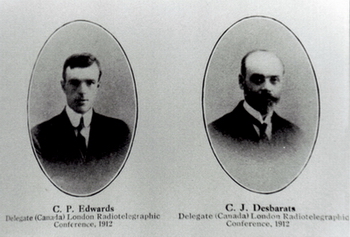
|
|
MWTCC W/Tp Events of 1922
Governor-General and Lady Byng threw the doors of Rideau Hall open to the public in connection with "The Fair of All Good Neighbours", for distressed and unemployment relief, on January 14, 1922. A small room fitted with a complete set of wireless receiving apparatus and 40 sets of ear-receivers was provided, courtesy of G.J. Desbarats and Cmdr. C.P. Edwards. The MWTCC transmitted a continuous radio-telephone concert from Montreal and then another concert was brought in on a different wave-length from the Naval Radio Station in Ottawa, as well as W/Tg messages from the U.S., England, France, Germany, and ships at sea (128). This was the first opportunity for the Ottawa public to hear wireless telephony.
Feb 16 - 9AM / CFCF Concert Party
Marconi Wireless broadcast "a concert party" from William Street on February 16, introduced by D.R.P. Coats. The first number was a song by "Gus" Hill and Willie Eckstein played a number of selections on the piano (129).
The Move from William Street to Phillips Square
Under Walter Darling, CFCF announced that it would be moving from William Street to two large rooms in the penthouse of the new Canada Cement Building, Phillips Square on May 1 (130). The MWTCC signed the lease on May 12 (131), and on June 3, advised Marine & Fisheries that the move would be in the next few days (132).
The MWTCC requested permission to continue its broadcasting work without interruption during the move (130). They announced that, beginning on Monday, June 3, they would broadcast concerts every evening, 8 to 9 p.m., except Saturdays and Sundays, in addition to their daily programs of news, market reports, music and entertainment running from 1 to 1:30 p.m. (133).
CFCF, its transmitter now atop the Canada Cement Building, Phillips Square, passed inspection by the Radiotelegraphic Branch on December 14, 1922: its emitted wave was sharp and its wave length increased from 420 to 440 metres. The renewed license also specified an inverted-L antenna, 62 feet long, seven wires and down-lead of 50 feet (134).
A.H. Morse Addressing the Montreal Publicity Association
At the Association at the Queen's Hotel, on June 6, A.H. Morse spoke of radio being accepted as a new and wonderful necessity, of great service to many aspects of industry, instrumental in cheering the sick in hospitals, for reaching isolated persons, weather reports and market prices for farmers, news headlines by radio instead of by the press, lectures for students by distinguished professors and politicians, notices by distributors of merchandise, and even concert singers. People could enjoy the music and sermons from churches, but many would be lazy and prefer to stay home from the village church to listen. Some boys may listen to a sermon in the barn "in the intervals of an exciting rat hunt....The public might well object to advertisers on the radio as they do to advertising in films" (135). Effective June 15, Mr. J.H. Thompson, late chief engineer of the Radio Branch, took over as the company's chief engineer, replacing J.O.G. Cann (136).
In late December, A.H. Morse tendered his resignation as director and on the 27th as a director of Scientific Experimenter (137).
June 17 Radio Week
Another outreach by the MWTCC was "Radio Week", announced on June 17, a unique entertainment in which the station arranged for six theatres of the Independent and United Amusements Ltd., to install Marconi model C regenerative receiver sets and Magnavox amplifiers in their houses. After the regular show, the Marconi station would broadcast a special radio concert demonstration from 8:30 p.m., featuring known artists, such as Willie Eckstein, "Gus" Hill, xylophonist Armand Meerte, pianist Miss Vera Guillaroff, the Venetian Gardens' Dance Orchestra, Ciro's Trio, boy soprano Rogier Lariviere and others. Afterward, operators would try to pick up radio concerts from distant points (138).
Jack Dempsey interview, July 18, 1922; left to right: Mr. Yorston, sports editor of The Montreal Standard, William H. "Jack" Dempsey, Tom Duggan, Manager of the Mount Royal Arena and interviewer/engineer Walter Darling. At right, behind Mr. Darling, is the new 1.5 kW YC3 transmitter and, on a box below it is a stack of five piano-rolls, so CFCF must still have had the Layton Brothers player piano (PAC, C 66695) (The Marconi News, Jan. 1943, p. 8, courtesy Roger Hart; Mtl. Std., July 22, 1922, p. 37)

|
|
An open-air "Fete des Merveilles" on June 21 at Lafontaine Park featured fireworks, a parachute drop and a wireless concert from CFCF, with the usual cast of "Gus" Hill, Willie Eckstein, Vera Guilaroff, the Venetian Gardens' Orchestra and Howard Wyness, xylophone. Then the operators picked up a radio concert from WGY, Schenectady. (139).
Jack Dempsey Interview, July 18 1922
Dempsey was giving 4-round exhibition bouts in Montreal (140) and Coats invited the arena manager to bring the champ to the CFCF studio. Walter Darling recalled, "He was so retiring that I had to look for him after announcing him at the microphone. He had slipped around behind a group of studio visitors" (141). Introduced by Walter Darling, rather than the expected stentorian sound, Dempsey spoke with a very small voice, not registering in the meters, so Coats shoved him in the back, closer to the hanging phonograph horn. Dempsey was too absorbed in his script to object and, afterwards, he turned and said, "Gee! I'd rather fight TEN fights than do that again".(142). R.M. Ferguson of Havelock, Ontario later recalled that Mr. Darling, the announcer, had an excellent reading voice and "among his tasks was the nightly reading of Peter Rabbit et al." (143).
The Singing Bachelor on CFCF
Isidore Goldberg told how he first telephoned "Jack" Argyle, wanting to know if the station encouraged amateurs. The reply was "Sure, come on down". Mr Goldberg "arrived pronto, but without an accompanist. None being available, 'Jack' contrived to use the player piano. Thus, Mr. Goldberg made his radio debut over CFCF, possibly in December, 1922, singing 'April Showers' with a mythical 'Harvey Jones' at the piano" (144).
There is a photograph of the occasion, showing Mr. Goldberg singing into the hanging phonograph horn and, to the right is a fellow sitting at the piano. Perhaps he was the operator of the player-piano. Fifty years later, Mr. Goldberg returned to the station to sing once more, this time into a modern microphone, and was photographed again.
Isidore Goldberg (b.1891), "The Singing Bachelor" with hanging horn and player-piano operator, Eddie Gittleson, in the CFCF studio in the new Canada Cement Building, December 1922 (a return visit is shown in The Marconi News, March 1943, p. 8; courtesy Roger Hart and Jim Coats)
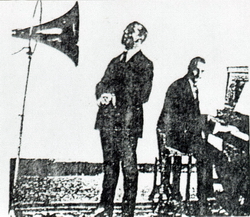
|
|
Mr. Goldberg, at one time a salesman for the Comfort Pants Company, Belgo Building, was a short man, an old bachelor with very bad eyes, always favouring bow-ties. He recalled that the station identification was given after every musical number, as "This is station CFCF, owned and operated by the Marconi Wireless Telegraph Company, Montreal, Canada" (144).
July 22 Atherton Lectures
"Darby" Coats, as publicity manager, thought that listeners should be reminded of Canada's history, so engaged Dr. William Henry Atherton, Prof. of History and Literature at the University of Montreal, in July, 1922 at no pay, to broadcast an educational and promotional series of weekly lectures on historic spots of Montreal (145) These were the first of their kind on Canadian radio, and the text of an undated talk by Atherton has survived, "The Beauty and Historic Spots of Montreal" (146). CFCF also broadcast a cooking show with Mlle. J. Babb of MacDonald College (147), a series by Mr. Harcourt Farmer, celebrated elocutionist (148) and another by Mr. M.F. Woods of English Marconi (149). By arrangement with the Canadian Forestry Association, Coats produced a series of 10-minute talks on forest protection (150).
D.R.P. Coats Leaves Marconi
D.R.P. Coats resigned from Marconi on March 16, 1921, after his last phone concert on Monday, March 6, but Managing Director A.H. Morse offered him a month's leave instead, and arranged for a trip to England, aboard the S.S. "Conqueror", May 2, returning June 2.
Coats resigned as Honorary Secretary of the Montreal Radio Association, January 30, 1922. He resigned from Marconi again on August 12, 1922 and joined the Perkins Electric, Ltd., Winnipeg. He married Amy Cooper on the 19th and they set off immediately by train for Winnipeg. For Perkins, he lectured all over Saskatchewan, Alberta and western Ontario, then left Perkins on March 2, 1923 for a position as announcer in charge of the Manitoba Telephone System's radio station CKY in Winnipeg. His first official broadcast there was on March 13, then was given charge of the MTS's publication "Broadcasting" on August 26 (Diary) and spent the rest of his career with CKY in Winnipeg (151).
Photo of "Darby" Coats at the microphone at CKY, Winnipeg
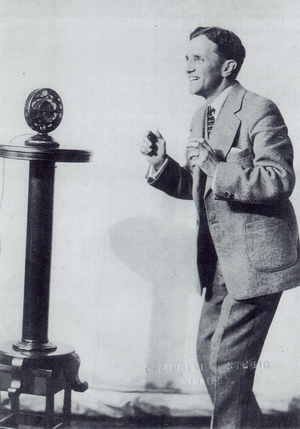
|
|
Oct 2 - Fairbanks - Pickford on CKAC
On October 2, CFCF missed the chance, when Mr. And Mrs. Douglas Fairbanks (a.k.a Mary Pickford) broadcasted a short talk in both French and English from the new La Presse Radio Station CKAC (152). A.H. Morse introduced the two stars and the MWTCC station did the actual transmission for CKAC.
The Question of Toll Broadcasting
On July 27, 1922, Managing Director Morse informed the Board that the company was operating the station at its own expense, and that expenses could be covered in the near future if they might do some toll broadcasting (153). Even in 1922, the American broadcasting model was unregulated, with indirect advertising heading toward quite overt and oppressive messaging. One critic foresaw radio becoming a "very troublesome pest....ears bombarded with advertising eulogies...the apparent harmlessness of the action.....makes it all the more likely to take hold" (154).
In Canada, however, the government was very slow to make progressive changes to the rules of broadcasting, after WW I still fearing that the new wireless medium was an opening for espionage.
At last, on September 1, 1922, the Canadian Minister of Marine recognized three new classes of radio licenses, private commercial (at 400-450 metres), amateur (at 250 metres) and private receiving, authorizing broadcasting of news, information, entertainment, etc., but prohibiting all from levying tolls or charges for any service (155). A "License to Use Radio,. Document" W-69, April 18, 1923, forbade collecting tolls or fees for any service (156).
Partly because of American competition providing better programming, an amendment on May 23, 1923, approved indirect advertising on Canadian radio and sponsoring of a program, only with the written permission of the minister.
Another amendment, in 1924, specified no collecting or receiving of tolls for any service, without the consent of the minister. Indirect advertising was permitted, as "This program was brought to you through the courtesy of....", and direct advertising allowed only between the hours of 6:30 to 11:00 p.m. (157).
CFCF licence #24 for 1923 was issued by the Deputy Minister of Marine and Fisheries on April 15, 1923, expiring on March 31, 1924 (158), to broadcast 1:00 to 1:45 p.m. daily and 7:30 to 9:30 p.m, Monday, Wednesday and Friday. The evening programs consisted of bed-time stories, Youth's Companion Stories, lectures, recitations, vocal, instrumental and dance music, time signals, weather forecasts, news bulletins and government radio news service.
October 22 - Official Weather Reports
CFCF became the official distribution centre for meteorological weather forecasts, authorized by the Dept of Marine and Fisheries on October 16 and 20, 1922 (158). The MWTCC proposed airing the official weather reports at 1:00 p.m. each day (159).
Up to that point there was still no regular, day-long broadcasting service in Montreal or anywhere in Canada. For that, local radio fans had to tune in KDKA Pittsburgh, WJZ Newark, WGY Schenectady, WWJ Detroit or KYW Chicago (160). With so few stations on the air and little interference, these distant stations came in quite reliably on ordinary W/Tp receivers. Over the succeeding years, with increasing competition from dozens of local Canadian stations, the government had to further relax the restrictions on program content and advertising.
REFERENCES
- Antique Phonograph News, Summer, 2020
- A.H. Morse, "Telegraph and Telephone Age", Dec. 1, 1924, p. 553
- NYT, January 29, 1909, p.1
- Sessional Paper #38, vol. 1 #26, p. 86, 5 George V, 1915.
- MDS, June 8, 1915, p. 1; "Chased, Shelled and Torpedoed" by D.R.P. Coats, Atlantic Advocate, August 1965, p. 63.
- Letter from G.H. Pearson, Ass't Traffic Mgr., May 10, 1916; Inter-official memo to Pearson, January 9, 1918, courtesy James Coats
- The Wireless World, February 1918, p..704
- Letter from G.B. Thorne, Riordan Pulp & Paper to Dept. of Militia & Defence, .Q.C1217, 18-6-18, June 1, 1918, courtesy James Coats
- MDS, May 8, 1919, p. 3
- D.R.P. Coats diary, courtesy James Coats
- MWTCC Inter-official memo, May 26, 1921; Ref. M.D. 239
- Antique Phonograph News, Summer 2020, p. 5
- Minutes, MWTCC Board, March 20, 1919, p. 66
- "Early Days of Canadian Broadcasting: Adventures in Radio" #14 in Manitoba Calling, by D.R.P. Coats, October 1941
- H.S. Putnam, Publicity Dept., Canadian Marconi Company; undated
- "La radio d'hier a aujoudhui' by Giles Proulx, in Libre Expression, 1986; "L'adventure de la radio a Quebec" by Gerald Resking, La Presse, 1979
- "CKAC - Une histoire d'amour" by Roger B. Stanke, Montreal, 1982
- "Marconi the Man - Marconi the Company", CMC interdepartmental manuscript from W.J. O'Brien, October 22, 1956, p. 3
- Testimony, March 11, 1932; in "The Success and History of C.F.C.F. Radio 600" , compiled for RCA SPC-407 by Jim Kidd from the CFCF Library, his collection and from Ed Manning and Hank Fleishman for Golden Anniversary,1969
- "The Success and History..." , ibid.
- Canadian Wireless, Vol. 2 #1, p. 6, June, 1921
- Minutes, Executive Cttee, MWTCC, Sept. 24, 1919, p. 3
- Canada Gazette, October-December, 1919, p. 1786
- "Communications Yesterday, To-day and To-morrow", Coats' lecture to Dauphin Chamber of Commerce, Feb. 20, 1957; courtesy James Coats
- "Early Days...", #14, op. cit..
- "Canada's Fifty Years and Stories Stations Tell: Featuring the Pioneer Station XWA, later given the call letters CFCF, 1919-1969" by D.R.P. Coats, unpublished manuscript, from Canadian Marconi Company Library, post 1969, p. 23
- "Putting Canada on the Air" by Donald E. Bankart, McLean's Magazine, Nov. 15, 1920, p. 14
- MDS, Jan. 21, 1920, p. 4
- QST, March, 1920, p.46
- Antique Phonograph News, May-June 2003; APN, May-June 2004
- MDS, March 9, 1920, p. 21
- Mtl. Gaz, March 10, 1920, p. 4
- "Communications Yesterday, To-day and To-morrow" , op. cit.
- A.J. Lorimer to D.R.P. "Drip" Coats, Dec. 27 1940 ; from Marconi Company discard, courtesy Roger Hart, April 8, 1998
- "Early Days..." #17, op. cit..
- "Early Days..." #15, p. 6, op. cit..
- "Early Days..." #13, p.7 and #14, p. 6, op. cit..
- Acoustic discs Apex 566; Apex 609; HMV 216242B
- "Three Montreal Jazz Pianists from the Jazz Age: Willie Eckstein, Harry Thomas and Vera Guilaroff" by Jack Litchfield, self-published, Toronto, 2015
- "Early Days..." #15, p. 6. op. cit.; "Canada's Fifty Years...", op. cit., p. 26
- "Canada's Fifty Years...", op. cit,.p. 32; Canadian Wireless, Vol. 1 #8, January, 1922.
- Dept. Naval Service to MWTCC, August 15, 1920; 209-6-1
- MWTCC To Naval Services, August 23, 1920; 209-1-1
- TDS, September 8, 1920, p. 2; D.R.P. Coats to Hugh Templin, Calgary, January 27, 1961; courtesy of James Coats; "Canada's Fifty Years...", op. cit., p. 29B
- Comments by Fred A. Barrow, undated (courtesy Roger Hart); "Early Days..." #16 & #17, op. cit.; "Canada's Fifty Years...", op. cit. p. 30
- G., September 4, 1920, p. 9
- TDS, September 3, 1920, pp I &.18
- TDS, Sept. 4, 1920, p. 16; Eve.Tel. September 8, 1920, p. 22.
- MDS, Nov. 30,1920, p 2
- Eve Tel.., March 1, 1921, p. 9; M & E, March 21, 1921, p. 2
- "Canadian Music & Trades Journal", Dec. 1920, p. 88; "Roll Back the Years", by Edward B. Moogk, National Archives, Ottawa, 1975
- "Canadian Wireless", Vol. 1 #1, June, 1921
- MDS, April 13, 1921, p 25
- MDS, April 20, 1921, p. 14
- Inter-departmental memo to W.V. George, August 29, 1962; in F.A. Barrow notes re 1920-22; courtesy of Roger Hart
- "Early Days...", op. cit., vol, 5 #10, p. 13
- MDS, March 17, 1922
- "Early Days...", #15, op. cit.
- Notes by D.R.P. Coats, courtesy James Coats, October 20, 2000
- "Canada's Fifty Years..." op. cit. ., p. 32
- Canadian Wireless, Vol. 1 #8, p. 4, January, 1922; "Early Days..." #22, p. 14, op. cit.
- "Canada's Fifty Years...", p. 32, op. cit.; Can. Wireless, Vol. 1 #8, January, 1922
- TDS, Dec. 25, 1921, p. 1
- Telephone conversation with Bill Tarling, January 12, 2001
- "Canada's Fifty Years...", p. 33, op. cit; personal communication from John Rutherford of CAPS, Oct. 2000
- TDS, June 16, 1920, p. 3; MDS, June 16, 1920, p. 2; "A History of the Marconi Company" by W.J. Baker; Methuen & Co., 1970)
- LT, April 14, 1919, p 15c
- LT, May 16,1919, p. 14d
- LT, Apr. 19, 1920, p.15b
- LT, June 15, 1920, p.16e
- LT, Feb. 12, 1921, pp. 11-12
- LT, Mar. 5, 1921, p. 13d
- LT, April 15, 1921, p. 9d
- LT, Jan. 5, 1921, p. 13b
- LT, May 5, 1921, p. 7a
- LT, June 4, 1921, p. 13a, ibid, June 6, p. 10e
- MDS, June 13, 1921, p. 22
- Evening News, May 9, 1921; courtesy Sandy Ross, President, Lilydale & District Historical Society, Dec. 9, 2004
- MDS, June 13, 1921, p. 6
- La Presse, Mtl., June 14, 1921, p. 7
- Mtl. Gaz., June 14, 1921, p. 3
- MDS, June 14, 1921, p. 2
- Mtl. Std. June 18, 1921, p. 25
- Mtl. Gaz., ibid; MDS, June 14, 1921, p. 2
- MDS, June 10, 1921, p. 18
- The National Library of Australia, Oct. 22, 2001
- The State Library of New South Wales, Nov. 2 and 15, 2001
- The Lilydale & District Historical Society, Dec. 9, 2004
- Letter from Pamela, Lady Vestey, Coombe Cottage, Coldstream, Victoria, Australia, August 1, 1995
- "Canada's Fifty Years and Stories Stations Tell: Featuring the Pioneer Station XWA, later given the call letters CFCF, 1919-1969" by D.R.P. Coats, unpublished manuscript, from Canadian Marconi Company Library, Montreal, 1969, p. 27
- APN, summer 2020, pp. 5 -15
- MDS, May 17, 1919, p. 2; MDS, May 27, 1919, p. 2
- Van. Sun, June 21, 1921, p. 7
- Van. Sun, June 29, 1921, p. 4
- Van. Sun, July 3, 1921, p. 1
- Van. Sun, July 5, 1921, p. 1
- The Bulletin, Sydney, August 11, 1921 p. 42
- LT, Sept. 6, 1921, p. 9c
- LT, Oct. 6, 1921, p. 9g
- LT, Nov. 1, 1921, 8d
- "Nellie Melba: The London Recordings, 1904-1926"; a 5 LP set, on EMI RLS 719
- Mtl Std, July 9, 1921, p. 11
- "Canada's Fifty Years...", ibid,, p. 37
- MDS, July 2, 1921, p. 1
- Mt. Std., July 23, 1921, p. 15; Mtl. Std. July 30, 1921, p. 5; Eve Tele, Toronto, July 25, 1921, p.17
- MDS, Jul 27, 1921, p 18
- Mtl. Std., Oct. 1, 1921, p. 2; Elec. News, Vol. 31 #19, Oct. 1, 1921, p. 43; Marconi News, Vol. 6 #8, August 1946, p. 4; "Canada's Fifty Years..." Ibid., , p. 38
- MDS. December 5, 1921, p. 1
- Coats' diary, Nov. 29. 1921, courtesy Jim Coats; J. Royal Astronomical Society, Vol. XVI, p. 63, 1922
- Coats' diary, December 15, 1921, ibid.
- Coats' diary, ibid., December 13, 1921; McGill Daily, December 14,1921, p. 21
- Verdun Free press, March 2, 1922; Coats' diary, March 13, 1921, ibid.
- Coats' diary, April 13, 1922, ibid.
- QST, January 1922, p. 29
- Official List of Radio Stations of Canada, Dept. Of Marine & Fisheries, August 1, 1922, p. 7; QST, November 1921, p. 47; Consolidated Radio Call Book Co., Inc. 3rd edition, 192,; 41 Park Row, New York City; The Radio Review, Dec. 1924, p. 71
- QST, November, 1921, p. 28
- P.A.C. RG 97, vol. 149, file 19 6206-72, pt..1, January 6, 1922
- From G.J. Desbarats, Depy Min. Naval Dept., P.A.C, WAR-N 209-32-10.
- Can. Wireless,, Vol. 1, #8, p. 2, January 1922; P.A.C., RG 97, Vol. 149, file 6202-72. Part 1; MWTCC, Board Minutes, Nov. 30, 1922, Book V, p. 104
- QST, November, 1921, p. 47
- G.J. Desbarats to MWTCC, March 14, 1922; P.A.C. RG 97, Vol. 149 6206-72 part 1; Marconi file April 12, 1922, 246-6-54 and 209-32-10).
- P.A.C. RG 97 Vol. 149 file 6202-72, part 1
- Can. Wireless, Vol. 1 #11, April 1922
- Mtl. Std., May 6, 1922, p.28
- Can. Wireless, Vol. 2 #1, June 1922, p. 6
- J. House of Commons, vol. LIX, June 27, 1922, p. 517
- Can. Wireless, Vol. 1 #12, May 1922, p. 9
- Ott. Eve J. Jan. 14, 1922, p. 10; Jan.16, 1922, p. 8
- MDS, Feb. 17, 1922
- CMC History, MG 28 111 72, vol. 7, no date
- RG 97 Vol. 149 file 6206-72, part 1, dated June 2, 1922
- La Presse, June 3, 1922; Can. Wireless, Vol. 2 #1, p. 6, June, 1922; Official List of Radio Stations of Canada, August 1922, p. 26.
- Dept. of Marine 209-32-10, Dec. 14, 1922
- MDS, June 7, 1922, p. 18; Mtl Gaz, June 8, 1922, p. 4
- Minutes of Bd of Directors, MWTCC, Book V, June 13,1922
- PAC MG 28 111 72, Vol. 11
- Mtl Std. June 17, 1922, p. 27; MDS June 19, 1922, p. 6; La Presse, June 21, 1922, p.1; MDS, June 22, 1922, p. 6; adio News of Canada, Vol. 1 #1, July 1922, p. 48
- La Presse, June 21, 1922, pp. 1 and 16
- Mtl Gaz, July 18, 1922, p. 15
- "Canada's Fifty Years,...". op. cit., p. 42
- Mtl. Std., July 22, 1922, p. 37; Manitoba Calling, Adventures in Radio #22, vol. 5 #10, p. 13, October 1941; "Canada's Fifty Years..." op. cit., p. 42
- Letter from R.M. Ferguson, G, February 13, 1985
- The Marconi News, March, 1943, p. 8
- Personal communication from Ronald Feingold, Jewish Public Library, Montreal
- La Presse, Sept. 25, 1922, p. 9; Manitoba Calling, Adventures in Radio #22, p. 14, October, 1941; "Canada's Fifty Years...". op. cit. p. 40
- "The Beauty and Historic Spots of Montreal", courtesy Denis Plante, U. de Mtl., mailed Oct. 31, 1995
- La Presse, August 14, 1922, p. 5
- La Presse, August 26, 1922, p. 8
- La Presse, Sept. 1, 1922, p. 9
- Can. Wireless, Vol. 2 #2, July, 1922
- Personal communication, courtesy Jim Coats
- La Presse, Oct. 3, 1922, p. 19; Can. Wireless Vol. 2 #5, p. 7, 1922
- P.A.C, MG 28 111, 92, Book 7, July 27, 1922; MWTCC Minute Book. V, p. 76
- Joseph H. Jackson, Radio Broadcast News, November 1922, pp. 72-76
- Frank Foster "Broadcasting Policy Development", Franfrost Communications, Ottawa,1982, p. 6
- P.A.C., RG 97, Vol. 149, 6206-72-1
- Letter from Deputy Minister,1924, in "Documents of Canadian Broadcasting"; ed. Roger Bird, Carlton University Press, Ottawa 1988, pp 31-36
- P.A.C. Rg 97 Vol. 149 file 6202-72
- P.A.C. Marine Records, Oct. 24, 1922, letter No. 8853, Oct. 23, 1922
- MDS, April 15, 1922, p. 21
Reference keys:
CMC - Canadian Marconi Company
Eve. Tele. - Evening Telegram newspaper, Toronto
G - Globe newspaper, Toronto
La Presse, Montreal
LT - London Times
M & E - Mail and Empire newspaper, Toronto
MDS - Montreal Daily Star newspaper
Mtl Gaz. - Montreal Gazette newspaper
Mtl Std - Montreal Standard
NYT - New York Times newspaper
Ott. Eve. J. - Ottawa Evening Journal
P.A.C. - Public Archives of Canada, Ottawa
QST - Magazine of the American Radio Relay League
TDS - Toronto Daily Star newspaper
Van Sun - Vancouver Sun
Thanks to:
Roger Hart, Morrisburg, Ontario
James Coats, Guelph, Ontario
Bill Pratt of CAPS
Public Archives of Canada, Ottawa
Dr. Arthur E. Zimmerman is the author of In the Shadow of the Shield: The Development of Wireless Telegraphy and Radio Broadcasting in Kingston and at Queen's University, 1902-1967, a 657-page hardcover book, illustrated and thoroughly referenced, available from the author at arthurz@look.ca.
A referee for the Ontario Heritage Foundation grant said of this 1991 book: "This is clearly a work for the historian or reader in the history of science, technology and engineering. The work is well documented, draws carefully from a variety of sources and, most important of all...preserves valuable oral evidence....fills an important need....see it as standing the test of time....provides local history that is truly different and, more important, a source of great insight".
|
The book's core is the Queen's Radio Oral History Project (OHP), researched, produced and hosted by Arthur for the 60th anniversary of CFRC in 1982. The OHP, 24 one-hour programs, searchable as CFRC Oral History Project, preserves incredible recordings: Marconi's voice, the trumpeter of the first 1922 broadcast, local hams and artists of the 20s and 30s, FDR's speech at Queen's, the Queen's-CBC Summer Radio Institute of the 1940s, many oral histories and historic treasures.
|
|
|